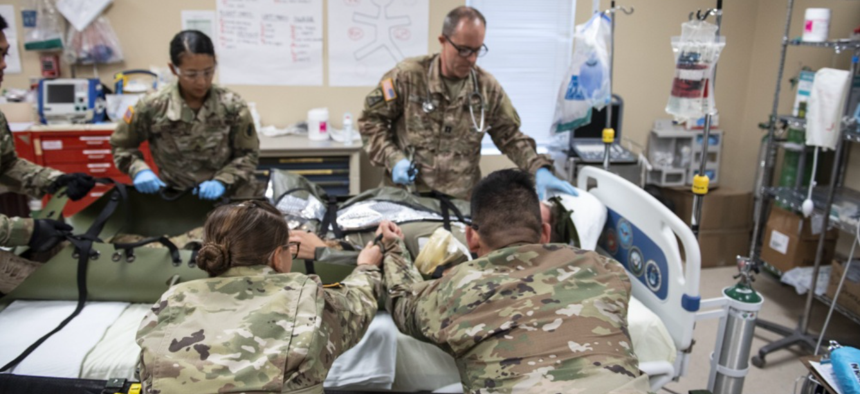
The 1st Battalion 228th Aviation Regiment practices 9-line medical evacuations at Soto Cano Air Base, Honduras, Dec. 12, 2018. u.s. air force photo by senior airman destinee sweeney
DARPA Is Trying Bioelectric Implants to Help Heal Wounds
One of the Pentagon’s new research programs could see biosensors, actuators and even artificial intelligence implanted in soldiers to speed up the body’s healing processes.
The Defense Department’s research wing has created a new program office to develop bioelectronic implants that stimulate tissue recovery in complex wounds, such as those suffered by troops in battle.
The Bioelectronics for Tissue Regeneration program, which the Defense Advanced Research Projects Agency announced Tuesday, is looking for advancements in biosensors, actuators and artificial intelligence that could “dramatically improve” tissue regeneration.
DARPA will host a proposers day on March 1 in Arlington, Virginia to provide more information to interested researchers.
The Pentagon is exploring bioelectronics as a means to improve military readiness. According to the Defense Department, 23 percent of blast injuries sustained by soldiers will not fully close, and nearly two-thirds of military trauma patients suffer a condition known as heterotopic ossification, “a painful experience that can greatly limit future mobility.”
Under traditional “passive” approaches to treatment, catastrophic damage to bones, skin and nerves take months to years to heal and often patients don’t fully recover. DARPA’s BETR program wants to connect technology to human tissue to monitor, accelerate and improve the body’s recovery process.
“Wounds are living environments and the conditions change quickly as cells and tissues communicate and attempt to repair,” said Paul Sheehan, BETR program manager. “An ideal treatment would sense, process and respond to these changes in the wound state and intervene to correct and speed recovery. For example, we anticipate interventions that modulate immune response, recruit necessary cell types to the wound or direct how stem cells differentiate to expedite healing.”
One of the important breakthroughs BETR is hoping for is a mechanism for monitoring the body’s physiological processes in real time. Whereas the application of an adaptive treatment like antibiotic ointment is useful in treating cuts, completely wiping out natural bacteria can impair healing.
“Thus, without feedback, antibiotics can be counterproductive,” Sheehan said. Bioelectronics could monitor changes in bacteria within the wound and use an available signal—optical, biochemical, bioelectric or mechanical—to monitor healing and stimulate or reduce the body’s physiological processes when necessary.
“By the conclusion of the four-year BETR program, DARPA expects researchers to demonstrate a closed-loop, adaptive system that includes sensors to assess wound state and track the body’s complex responses to interventions; biological actuators that transmit appropriate biochemical and biophysical signals precisely over space and time to influence healing; and adaptive learning approaches to process data, build models and determine interventions,” DARPA said.




